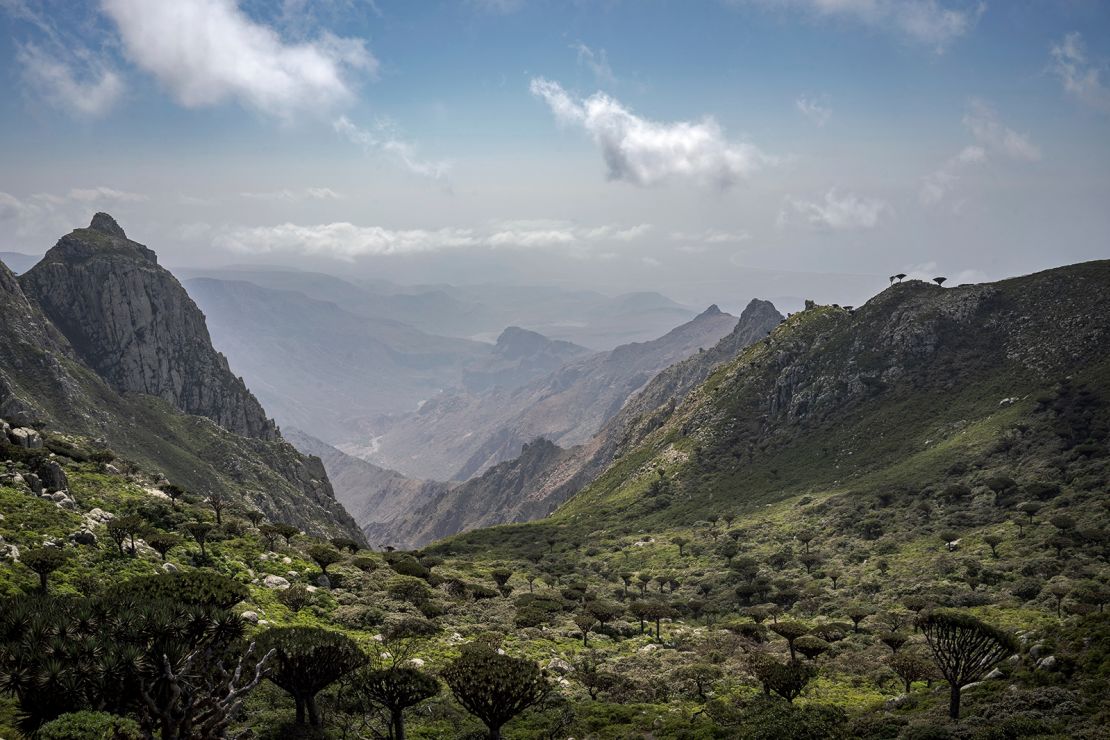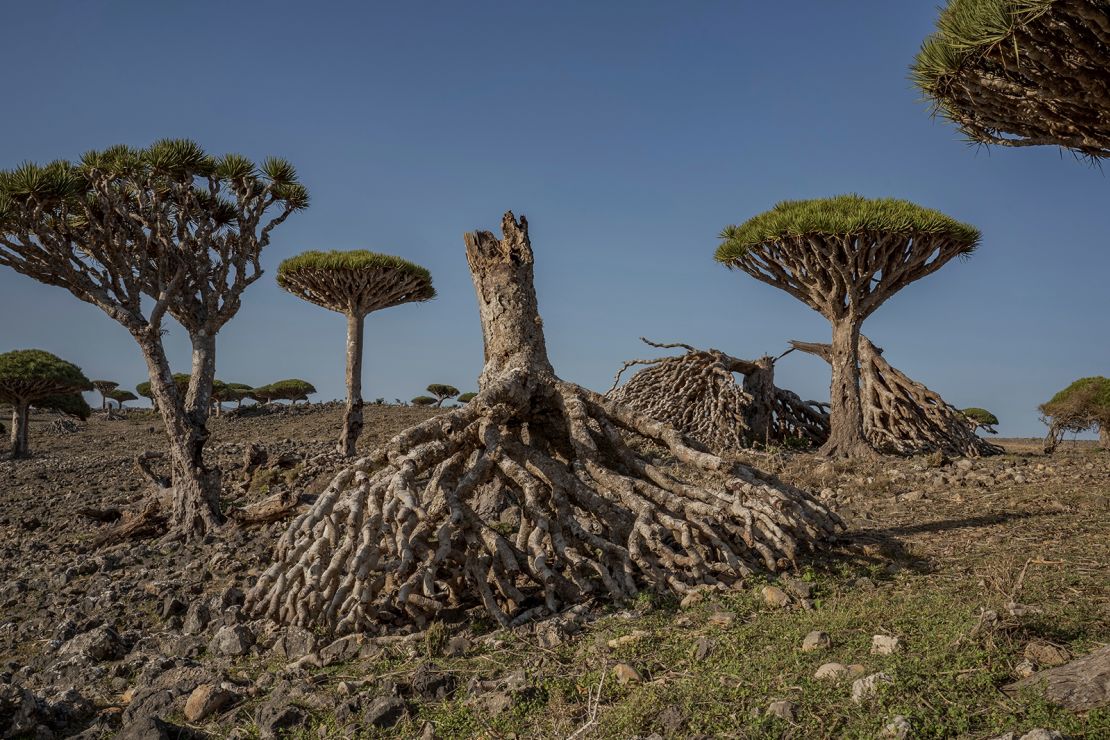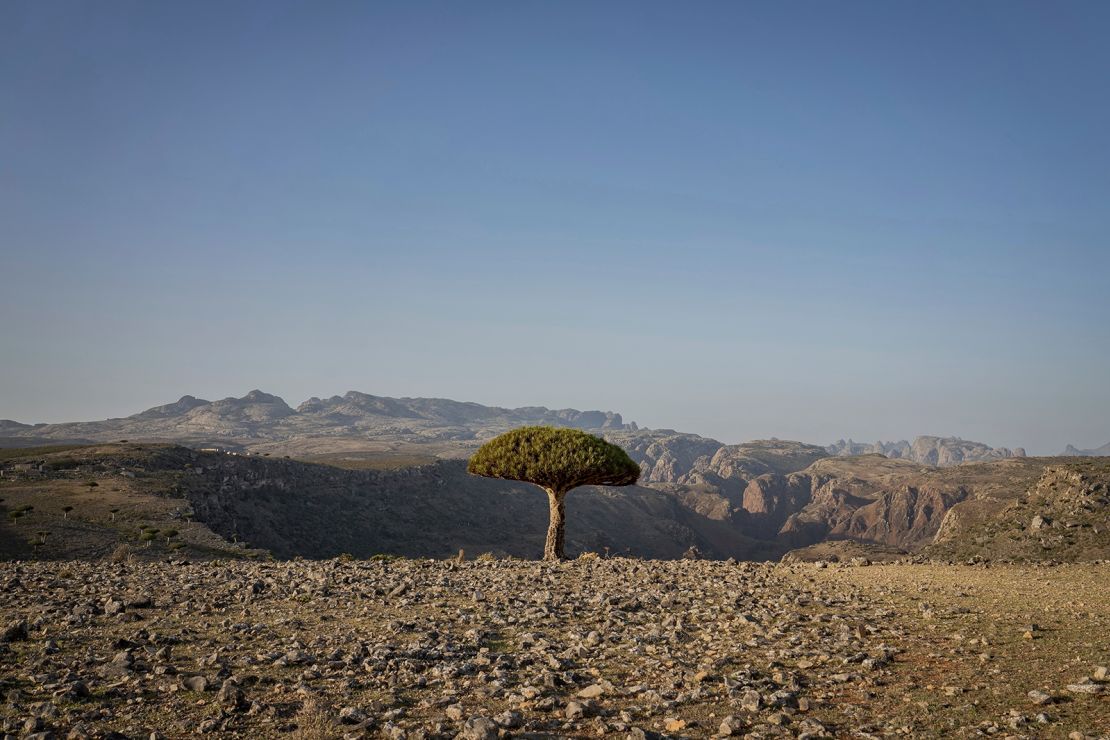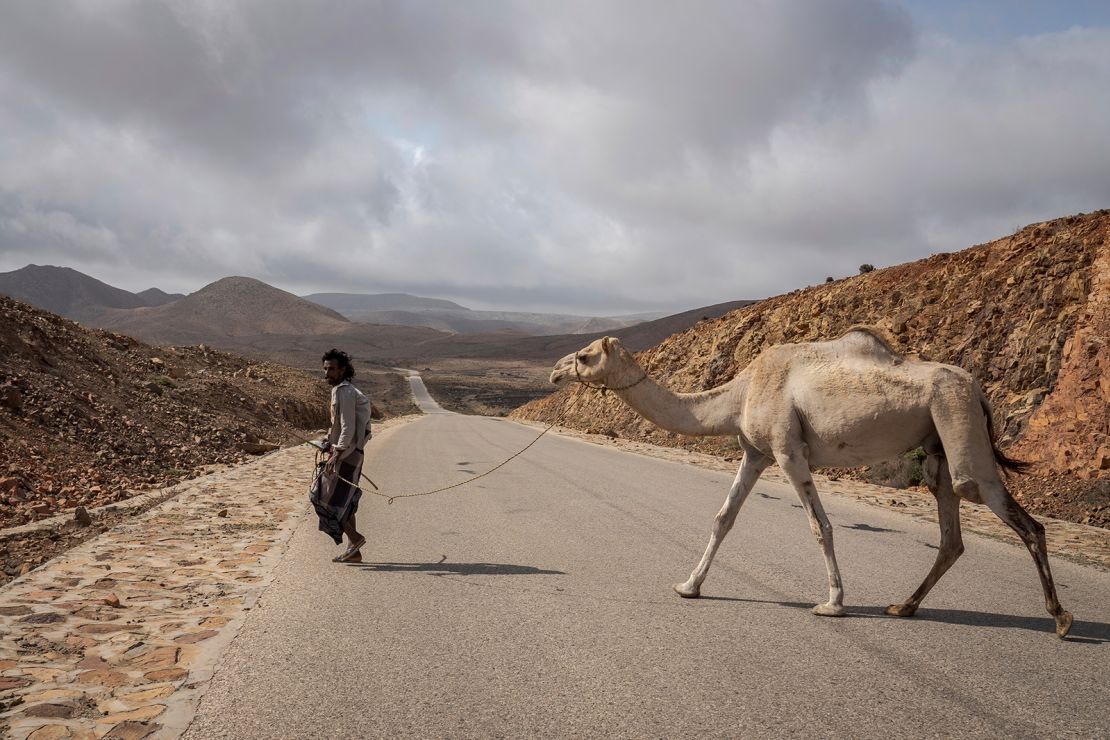These dragon’s blood trees exist in only one place on Earth. Now their survival is under threat

On a windswept plateau high above the Arabian Sea, Sena Keybani cradles a sapling that barely reaches her ankle. The young plant, protected by a makeshift fence of wood and wire, is a kind of dragon’s blood tree — a species found only on the Yemeni island of Socotra that is now struggling to survive intensifying threats from climate change.
“Seeing the trees die, it’s like losing one of your babies,” said Keybani, whose family runs a nursery dedicated to preserving the species.
Known for their mushroom-shaped canopies and the blood-red sap that courses through their wood, the trees once stood in great numbers. But increasingly severe cyclones, grazing by invasive goats, and persistent turmoil in Yemen — which is one of the world’s poorest countries and beset by a decade-long civil war — have pushed the species, and the unique ecosystem it supports, toward collapse.
Often compared to the Galapagos Islands, Socotra floats in splendid isolation some 240 kilometers (150 miles) off the Horn of Africa. Its biological riches — including 825 plant species, of which more than a third exist nowhere else on Earth — have earned it UNESCO World Heritage status. Among them are bottle trees, whose swollen trunks jut from rock like sculptures, and frankincense, their gnarled limbs twisting skywards.
But it’s the dragon’s blood tree that has long captured imaginations, its otherworldly form seeming to belong more to the pages of Dr. Seuss than to any terrestrial forest. The island receives about 5,000 tourists annually, many drawn by the surreal sight of the dragon’s blood forests.
Visitors are required to hire local guides and stay in campsites run by Socotran families to ensure tourist dollars are distributed locally. If the trees were to disappear, the industry that sustains many islanders could vanish with them.
“With the income we receive from tourism, we live better than those on the mainland,” said Mubarak Kopi, Socotra’s head of tourism.

But the tree is more than a botanical curiosity: It’s a pillar of Socotra’s ecosystem. The umbrella-like canopies capture fog and rain, which they channel into the soil below, allowing neighboring plants to thrive in the arid climate.
“When you lose the trees, you lose everything — the soil, the water, the entire ecosystem,” said Kay Van Damme, a Belgian conservation biologist who has worked on Socotra since 1999.
Without intervention, scientists like Van Damme warn these trees could disappear within a few centuries — and with them many other species.
“We’ve succeeded, as humans, to destroy huge amounts of nature on most of the world’s islands,” he said. “Socotra is a place where we can actually really do something. But if we don’t, this one is on us.”
Increasingly intense cyclones uproot trees
Across the rugged expanse of Socotra’s Firmihin plateau, the largest remaining dragon’s blood forest unfolds against the backdrop of jagged mountains. Thousands of wide canopies balance atop slender trunks. Socotra starlings dart among the dense crowns while Egyptian vultures bank against the relentless gusts. Below, goats weave through the rocky undergrowth.
The frequency of severe cyclones has increased dramatically across the Arabian Sea in recent decades, according to a 2017 study in the journal Nature Climate Change, and Socotra’s dragon’s blood trees are paying the price.
In 2015, a devastating one-two punch of cyclones — unprecedented in their intensity — tore across the island. Centuries-old specimens, some over 500 years old, which had weathered countless previous storms, were uprooted by the thousands. The destruction continued in 2018 with yet another cyclone.
As greenhouse gas emissions continue to rise, so too will the intensity of the storms, warned Hiroyuki Murakami, a climate scientist at the National Oceanic and Atmospheric Administration and the study’s lead author. “Climate models all over the world robustly project more favorable conditions for tropical cyclones.”
Invasive goats endanger young trees
But storms aren’t the only threat. Unlike pine or oak trees, which grow 60 to 90 centimeters (25 to 35 inches) per year, dragon’s blood trees creep along at just 2 to 3 centimeters (about 1 inch) annually. By the time they reach maturity, many have already succumbed to an insidious danger: goats.
An invasive species on Socotra, free-roaming goats devour saplings before they have a chance to grow. Outside of hard-to-reach cliffs, the only place young dragon’s blood trees can survive is within protected nurseries.
“The majority of forests that have been surveyed are what we call over-mature — there are no young trees, there are no seedlings,” said Alan Forrest, a biodiversity scientist at the Royal Botanic Garden Edinburgh’s Centre for Middle Eastern Plants. “So you’ve got old trees coming down and dying, and there’s not a lot of regeneration going on.”
Keybani’s family’s nursery is one of several critical enclosures that keep out goats and allow saplings to grow undisturbed.
“Within those nurseries and enclosures, the reproduction and age structure of the vegetation is much better,” Forrest said. “And therefore, it will be more resilient to climate change.”

Conflict threatens conservation
But such conservation efforts are complicated by Yemen’s stalemated civil war. As the Saudi Arabia-backed, internationally recognized government battles Houthi rebels — a Shiite group backed by Iran — the conflict has spilled beyond the country’s borders. Houthi attacks on Israel and commercial shipping in the Red Sea have drawn retaliation from Israeli and Western forces, further destabilizing the region.
“The Yemeni government has 99 problems right now,” said Abdulrahman Al-Eryani, an advisor with Gulf State Analytics, a Washington-based risk consulting firm. “Policymakers are focused on stabilizing the country and ensuring essential services like electricity and water remain functional. Addressing climate issues would be a luxury.”
With little national support, conservation efforts are left largely up to Socotrans. But local resources are scarce, said Sami Mubarak, an ecotourism guide on the island.
Mubarak gestures toward the Keybani family nursery’s slanting fence posts, strung together with flimsy wire. The enclosures only last a few years before the wind and rain break them down. Funding for sturdier nurseries with cement fence posts would go a long way, he said.
“Right now, there are only a few small environmental projects — it’s not enough,” he said. “We need the local authority and national government of Yemen to make conservation a priority.”
+++++++++++++++++++++++++++++++++++++++++++++++++++++++++++++
It’s time we stop
A prisoner swap is a symbolic step towards ending the Saudi-led war in Yemen
The Houthis are close to a Pyrrhic victory, but Yemen is still far from peace

They were rare scenes of joy in a war that has brought eight years of misery. For three days lines of grinning men (and the occasional woman) stepped off Red Cross planes in Sana’a and Aden, the biggest cities in Yemen. After years in captivity, some looked the worse for wear: faces drawn, black hair turned grey. But they were eager to embrace family members and celebrate their new-found freedom.

A total of 887 people were released in this month’s prisoner swap between the Houthis, a Shia rebel group that controls much of Yemen (see map), and the Saudi-led coalition that has been fighting them for eight years. Immediately after the exchange was complete, the Houthis mooted another, larger one. It was a further sign that both sides are nearing a deal to end their war. But peace in our time this is not: more likely it is the end of one conflict and the start of another.
It has been the most pointless of wars. At first Saudi officials said “Operation Decisive Storm” would remove the Houthis within weeks and restore Yemen’s internationally recognised government. That was 421 weeks ago. A Saudi-led bombing campaign has killed around 9,000 civilians, including guests at a wedding, children on a school bus and mourners at a funeral. The United Arab Emirates (uae), the coalition’s most effective army, began to withdraw most of its troops in 2019 after it concluded the campaign had reached a stalemate.
Where they once sought to overthrow the Houthis, the Saudis now have one overarching priority: to end their own involvement in the war, and the torrent of cross-border missiles and drones it has invited. The Armed Conflict Location and Event Data Project, an American monitoring group, says the Houthis have carried out more than 1,000 rocket or missile attacks on Saudi Arabia and flown at least 350 drones into the country since the war began.
Their attacks have become steadily more accurate: just 15% of them used guided munitions in 2015, a number that rose to 89% last year. Fatalities have been rare. Reputational damage has not. Last year the Houthis struck an oil depot in Jeddah days before the city hosted a Formula 1 race. The Saudis want to attract investors and tourists to help diversify their economy. Ballistic missiles tend to scare off both.
The cross-border attacks worked. After months of talks, on April 9th a Saudi delegation landed in Sana’a, the Yemeni capital, to discuss terms. The first step will probably be to extend a temporary truce agreed last April. Though it expired six months later, both sides have more or less continued to abide by it, and it may now be made permanent. The Houthis also want the Saudi-backed government to pay salaries for civil servants in areas they control.
For the Houthis, victory will be Pyrrhic. They survive to rule a ruined country. Fully 80% of its 30m people rely on foreign aid, and between 2015 and 2020 disease and famine killed at least 131,000. They have forced children into service as cannon fodder, stolen foreign aid, repressed women and turned schools into factories for indoctrination. None of this has endeared them to the populace.
The group has been fighting a civil war against the Yemeni state since the 1990s. Many Yemenis fear it will continue, despite any peace deal. The Houthis have offered vague words about power-sharing. “If we were not looking for full control during the war, then we will not look for full control at any other time,” Mohammed Ali al-Houthi, one of the group’s leaders, told cnn. A keen observer might recall that, during the war, the Houthis seized the capital in central Yemen and the main port in the west, then tried to capture Aden in the south and oilfields in the east, which looks an awful lot like vying for full control.
Add to that a bewildering mix of other disputes. Rebels in the south, who enjoy support from the uae, want their region to be independent, as it was from 1967 to 1990. Militias on the west coast want some measure of autonomy. So do those in Hadhramaut, in the south-east, an area that has long had a distinct identity from the rest of Yemen. These groups found a degree of common cause against the Houthis, but their unity may dissolve if they no longer perceive a shared threat.
Yemen has long been hard to govern. With so many foes and so little wider popular support, the Houthis will probably find the task impossible. The country will go on fragmenting. The Saudis did not want a hostile regime on their southern border. But what they and their allies have helped create in the past eight years—a patchwork of competing militias and ungoverned spaces—is hardly better.


